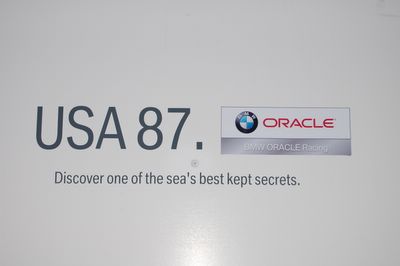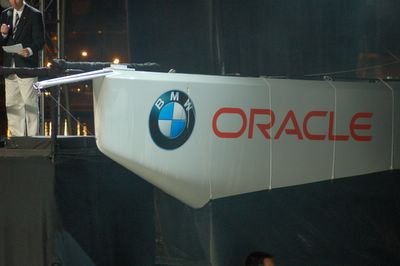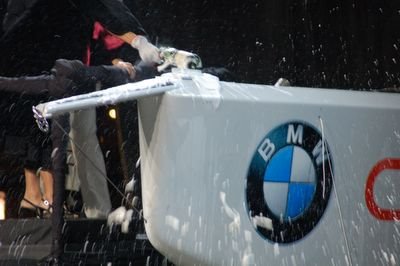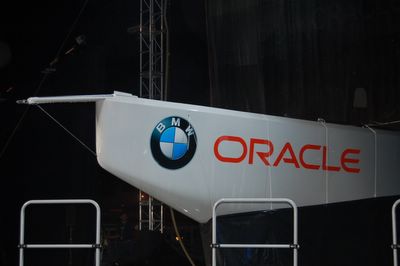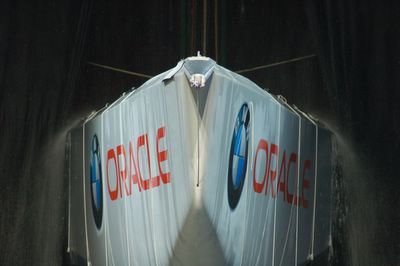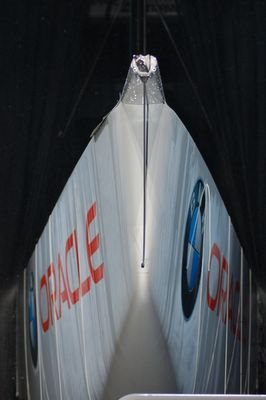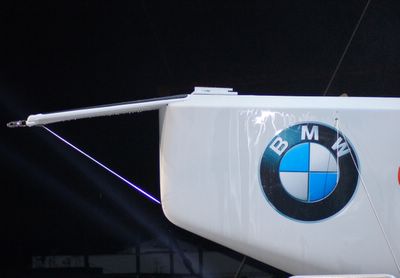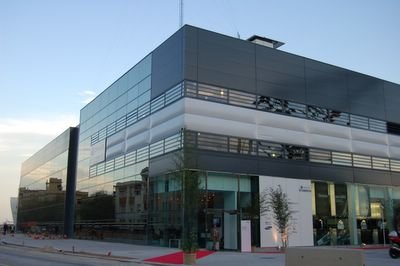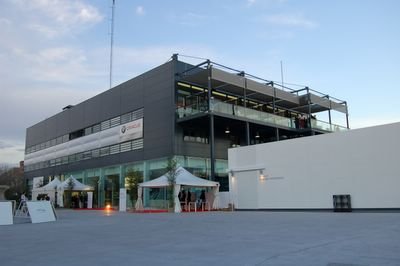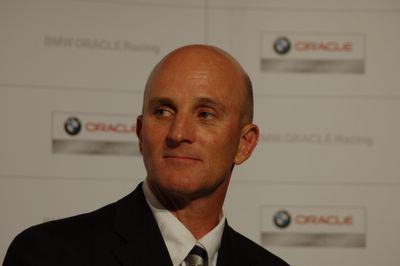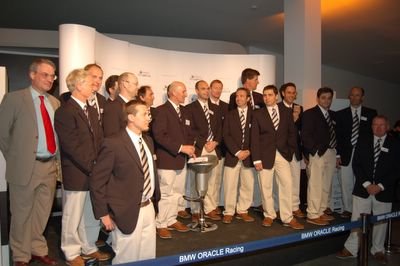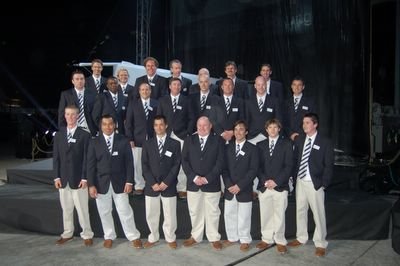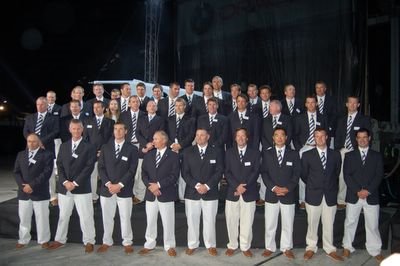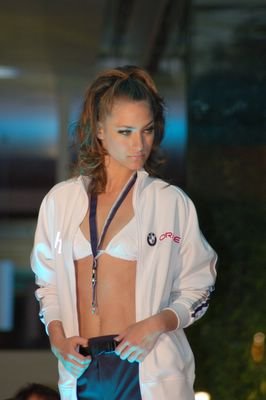Shosholoza, the soul of sailing
On Friday, Valencia Sailing had the chance to follow another team training session from a priviledged position. I was the 18th man aboard RSA-83, the yacht of Shosholoza, the first ever America's Cup challenger from South Africa.
The South African team trained together with United Internet Team Germany, following a schedule that allows both teams to evaluate and improve their performance.
Unfortunately, Friday's weather conditions were not ideal with sometimes wind dropping to 4-5 knots and as a result did not provide the perfect setting necessary to fully enjoy these boats.
 Stretching exercises before sailing. Valencia, aboard RSA-83, 31 March 2006. Photo taken by Pierre Orphanidis / Valencia Sailing
Stretching exercises before sailing. Valencia, aboard RSA-83, 31 March 2006. Photo taken by Pierre Orphanidis / Valencia Sailing Dee Smith (left), team manager, tactician and skipper, and Jason Ker (right), chief designer of Shosholoza and father of RSA-83, discussing the day's tactics and training plans. Valencia, aboard RSA-83, 31 March 2006. Photo taken by Pierre Orphanidis / Valencia Sailing
Dee Smith (left), team manager, tactician and skipper, and Jason Ker (right), chief designer of Shosholoza and father of RSA-83, discussing the day's tactics and training plans. Valencia, aboard RSA-83, 31 March 2006. Photo taken by Pierre Orphanidis / Valencia Sailing Muscle power in full use in order to hoist the mainsail. Valencia, aboard RSA-83, 31 March 2006. Photo taken by Pierre Orphanidis / Valencia Sailing
Muscle power in full use in order to hoist the mainsail. Valencia, aboard RSA-83, 31 March 2006. Photo taken by Pierre Orphanidis / Valencia Sailing Team Shosholoza starting the day's sailing. On the left, Tommaso Chieffi who joined Shosholoza last week as new helmsman. At the helms at that moment was Mark Sadler, new skipper of the team. Valencia, aboard RSA-83, 31 March 2006. Photo taken by Pierre Orphanidis / Valencia Sailing
Team Shosholoza starting the day's sailing. On the left, Tommaso Chieffi who joined Shosholoza last week as new helmsman. At the helms at that moment was Mark Sadler, new skipper of the team. Valencia, aboard RSA-83, 31 March 2006. Photo taken by Pierre Orphanidis / Valencia Sailing Team Shosholoza training. Valencia, aboard RSA-83, 31 March 2006. Photo taken by Pierre Orphanidis / Valencia Sailing
Team Shosholoza training. Valencia, aboard RSA-83, 31 March 2006. Photo taken by Pierre Orphanidis / Valencia Sailing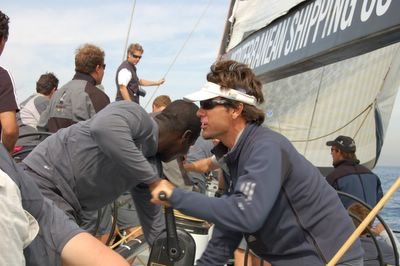 Grinders provide all the power needed to tack. Valencia, aboard RSA-83, 31 March 2006. Photo taken by Pierre Orphanidis / Valencia Sailing
Grinders provide all the power needed to tack. Valencia, aboard RSA-83, 31 March 2006. Photo taken by Pierre Orphanidis / Valencia Sailing Grinders provide all the power needed to tack. Valencia, aboard RSA-83, 31 March 2006. Photo taken by Pierre Orphanidis / Valencia Sailing
Grinders provide all the power needed to tack. Valencia, aboard RSA-83, 31 March 2006. Photo taken by Pierre Orphanidis / Valencia Sailing Shosholoza, the soul of sailing, during training. On the left, Marc Largesse, navigator of the team, together with his inseparable companion, the computer. Valencia, aboard RSA-83, 31 March 2006. Photo taken by Pierre Orphanidis / Valencia Sailing
Shosholoza, the soul of sailing, during training. On the left, Marc Largesse, navigator of the team, together with his inseparable companion, the computer. Valencia, aboard RSA-83, 31 March 2006. Photo taken by Pierre Orphanidis / Valencia Sailing Shosholoza, the soul of sailing, training in Valencia. 31 March 2006. Photo taken by Pierre Orphanidis / Valencia Sailing
Shosholoza, the soul of sailing, training in Valencia. 31 March 2006. Photo taken by Pierre Orphanidis / Valencia Sailing Shosholoza, the soul of sailing, training in Valencia. 31 March 2006. Photo taken by Pierre Orphanidis / Valencia Sailing
Shosholoza, the soul of sailing, training in Valencia. 31 March 2006. Photo taken by Pierre Orphanidis / Valencia Sailing Shosholoza, the soul of sailing, training in Valencia. 31 March 2006. Photo taken by Pierre Orphanidis / Valencia Sailing
Shosholoza, the soul of sailing, training in Valencia. 31 March 2006. Photo taken by Pierre Orphanidis / Valencia Sailing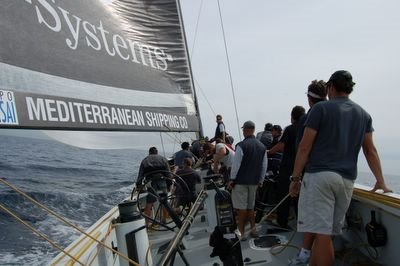 Shosholoza, the soul of sailing, training in Valencia. 31 March 2006. Photo taken by Pierre Orphanidis / Valencia Sailing
Shosholoza, the soul of sailing, training in Valencia. 31 March 2006. Photo taken by Pierre Orphanidis / Valencia Sailing Shosholoza, the soul of sailing, training in Valencia. 31 March 2006. Photo taken by Pierre Orphanidis / Valencia Sailing
Shosholoza, the soul of sailing, training in Valencia. 31 March 2006. Photo taken by Pierre Orphanidis / Valencia Sailing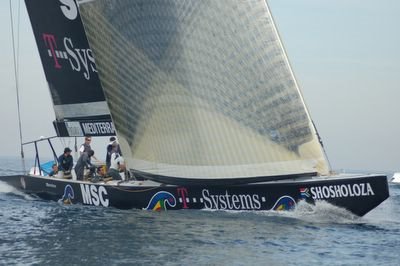 Shosholoza, the soul of sailing, training in Valencia. 31 March 2006. Photo taken by Pierre Orphanidis / Valencia Sailing
Shosholoza, the soul of sailing, training in Valencia. 31 March 2006. Photo taken by Pierre Orphanidis / Valencia Sailing Shosholoza, the soul of sailing, training in Valencia. 31 March 2006. Photo taken by Pierre Orphanidis / Valencia Sailing
Shosholoza, the soul of sailing, training in Valencia. 31 March 2006. Photo taken by Pierre Orphanidis / Valencia Sailing Shosholoza, the soul of sailing, training in Valencia. 31 March 2006. Photo taken by Pierre Orphanidis / Valencia Sailing
Shosholoza, the soul of sailing, training in Valencia. 31 March 2006. Photo taken by Pierre Orphanidis / Valencia Sailing Shosholoza, the soul of sailing, training in Valencia. 31 March 2006. Photo taken by Pierre Orphanidis / Valencia Sailing
Shosholoza, the soul of sailing, training in Valencia. 31 March 2006. Photo taken by Pierre Orphanidis / Valencia Sailing Shosholoza, the soul of sailing, training in Valencia. 31 March 2006. Photo taken by Pierre Orphanidis / Valencia Sailing
Shosholoza, the soul of sailing, training in Valencia. 31 March 2006. Photo taken by Pierre Orphanidis / Valencia Sailing Shosholoza, the soul of sailing, training in Valencia. 31 March 2006. Photo taken by Pierre Orphanidis / Valencia Sailing
Shosholoza, the soul of sailing, training in Valencia. 31 March 2006. Photo taken by Pierre Orphanidis / Valencia Sailing Shosholoza, the soul of sailing, training in Valencia. 31 March 2006. Photo taken by Pierre Orphanidis / Valencia Sailing
Shosholoza, the soul of sailing, training in Valencia. 31 March 2006. Photo taken by Pierre Orphanidis / Valencia Sailing Shosholoza, the soul of sailing, training in Valencia. 31 March 2006. Photo taken by Pierre Orphanidis / Valencia Sailing
Shosholoza, the soul of sailing, training in Valencia. 31 March 2006. Photo taken by Pierre Orphanidis / Valencia Sailing Shosholoza, the soul of sailing, training in Valencia. 31 March 2006. Photo taken by Pierre Orphanidis / Valencia Sailing
Shosholoza, the soul of sailing, training in Valencia. 31 March 2006. Photo taken by Pierre Orphanidis / Valencia Sailing Shosholoza, the soul of sailing, training in Valencia. 31 March 2006. Photo taken by Pierre Orphanidis / Valencia Sailing
Shosholoza, the soul of sailing, training in Valencia. 31 March 2006. Photo taken by Pierre Orphanidis / Valencia Sailing Shosholoza, the soul of sailing, training in Valencia. 31 March 2006. Photo taken by Pierre Orphanidis / Valencia Sailing
Shosholoza, the soul of sailing, training in Valencia. 31 March 2006. Photo taken by Pierre Orphanidis / Valencia Sailing Shosholoza, the soul of sailing, training in Valencia. 31 March 2006. Photo taken by Pierre Orphanidis / Valencia Sailing
Shosholoza, the soul of sailing, training in Valencia. 31 March 2006. Photo taken by Pierre Orphanidis / Valencia Sailing Shosholoza, the soul of sailing, training in Valencia. 31 March 2006. Photo taken by Pierre Orphanidis / Valencia Sailing
Shosholoza, the soul of sailing, training in Valencia. 31 March 2006. Photo taken by Pierre Orphanidis / Valencia Sailing Shosholoza, the soul of sailing, training in Valencia. 31 March 2006. Photo taken by Pierre Orphanidis / Valencia Sailing
Shosholoza, the soul of sailing, training in Valencia. 31 March 2006. Photo taken by Pierre Orphanidis / Valencia Sailing Shosholoza, the soul of sailing, training in Valencia. 31 March 2006. Photo taken by Pierre Orphanidis / Valencia Sailing
Shosholoza, the soul of sailing, training in Valencia. 31 March 2006. Photo taken by Pierre Orphanidis / Valencia Sailing Shosholoza, the soul of sailing, training in Valencia. 31 March 2006. Photo taken by Pierre Orphanidis / Valencia Sailing
Shosholoza, the soul of sailing, training in Valencia. 31 March 2006. Photo taken by Pierre Orphanidis / Valencia Sailing Shosholoza, the soul of sailing, training in Valencia. 31 March 2006. Photo taken by Pierre Orphanidis / Valencia Sailing
Shosholoza, the soul of sailing, training in Valencia. 31 March 2006. Photo taken by Pierre Orphanidis / Valencia Sailing Shosholoza, the soul of sailing, training in Valencia. 31 March 2006. Photo taken by Pierre Orphanidis / Valencia Sailing
Shosholoza, the soul of sailing, training in Valencia. 31 March 2006. Photo taken by Pierre Orphanidis / Valencia Sailing Shosholoza, the soul of sailing, training in Valencia. 31 March 2006. Photo taken by Pierre Orphanidis / Valencia Sailing
Shosholoza, the soul of sailing, training in Valencia. 31 March 2006. Photo taken by Pierre Orphanidis / Valencia Sailing








 The painting of the hull of CHN-79 is about to reach completion with only a few final touches left. The red dragon is now completely visible and without any doubt the result is very impressive. We visited the China Team shed this morning in order report on the progress of what will probably be the most beautiful America's Cup yacht. Our photos don't entirely do justice to CHN-79, given the obvious spatial constraints and less than ideal light conditions. We were after all inside a tent and not a photographer's studio.
The painting of the hull of CHN-79 is about to reach completion with only a few final touches left. The red dragon is now completely visible and without any doubt the result is very impressive. We visited the China Team shed this morning in order report on the progress of what will probably be the most beautiful America's Cup yacht. Our photos don't entirely do justice to CHN-79, given the obvious spatial constraints and less than ideal light conditions. We were after all inside a tent and not a photographer's studio. 




